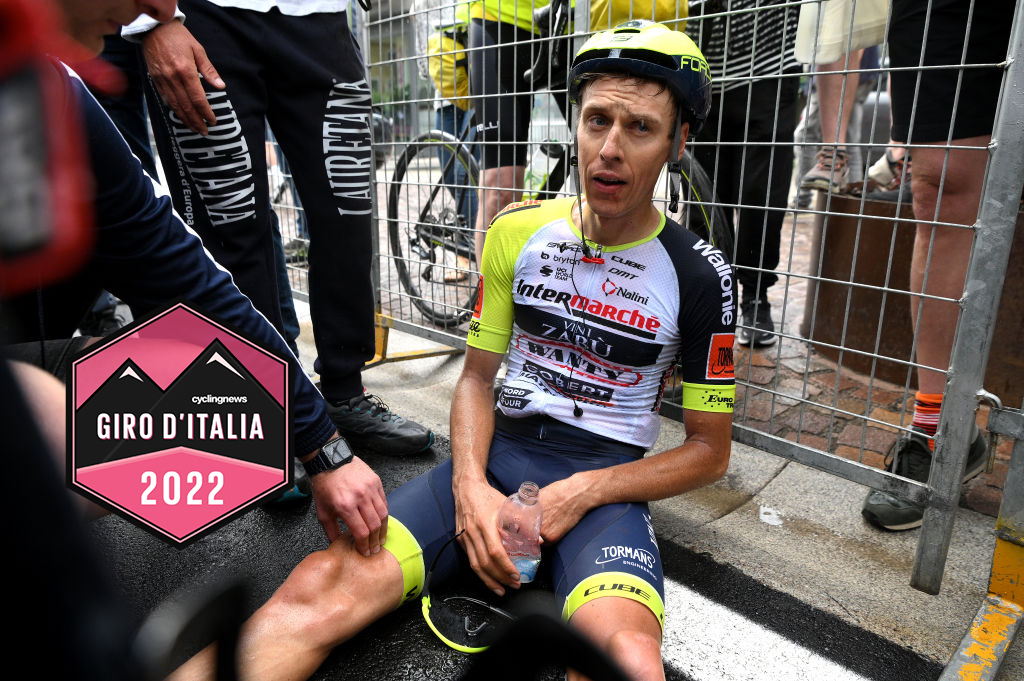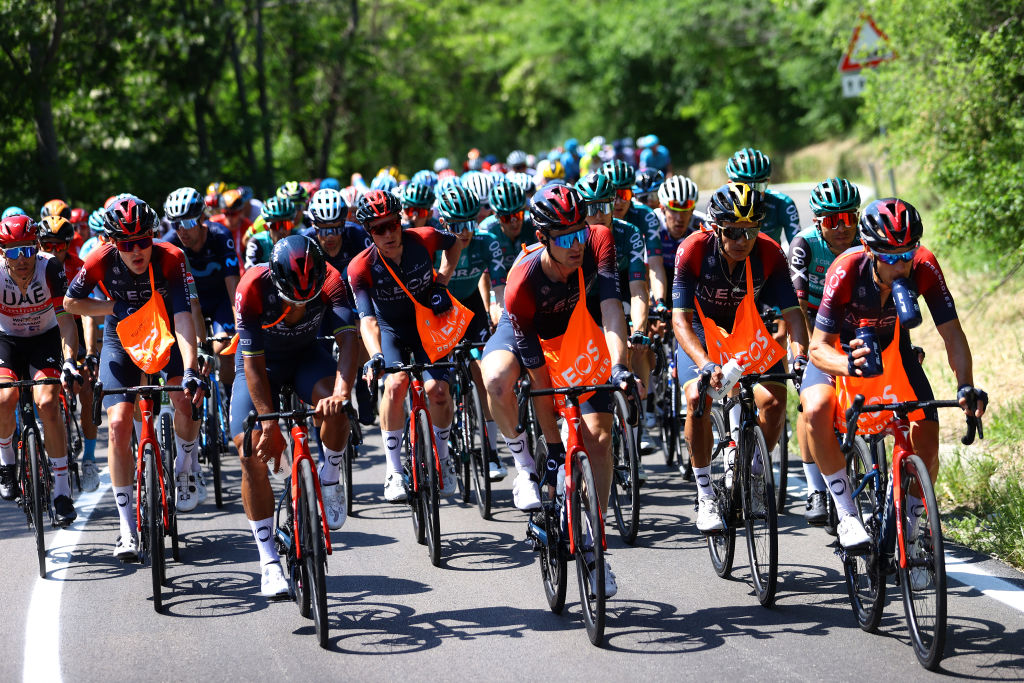How physically demanding is a Grand Tour?
We investigate the physical and mental challenge of racing for three very long weeks

The Giro d’Italia’s into its third week. It’s a time of division where dreams will either turn into reality or a nightmare. But one thing unites: fatigue.
With over 2,500km in their limbs, plus numerous mountains climbed, tiredness sweeps over the peloton with greater ferocity than an Arnaud Démare sprint. But that’s general. What about the specifics? In other words, what happens to a rider’s physiology and performance levels when the finish line edges closer?
It’s time to examine the degradation of the world’s best. We'll start with one of the newest sets of metrics to grace the cycling scene.
Those on their mailing list can’t failed to have noticed Whoop’s stream of emails charting riders’ physiological data over the course of the Giro d’Italia, while the metrics have also cascaded across Eurosport's live coverage. This includes what Whoop term the ‘strain score’ and is a summary of a rider’s cardiovascular load based on heart rate and how long a rider’s spent in personal heart-rate zones.
Whoop’s own algorithm calculates a rider’s exertions based on a scale from 0 to 21 with 0 to 9.9 light and 18-21 all-out. It also calculates a recovery score up to 100% fully recovered.
We can’t verify the accuracy of the device or the subsequent scores but here is a snapshot from Alpecin-Fenix’s data via Whoop’s PR team.
- Stage 1, 195km, Budapest to Visgegrad - The riders averaged 8:02hrs sleep the night before. The team had a 67% recovery on that same day and, with such a hard stage, the team averaged 20.3 strain across all eight riders.
- Stage 2, 9.2km, time-trial - The riders naturally enjoyed less sleep after such a hard stage, but also experienced a lower overall strain with just a TT. The TT day comprises a recon ride and warm-up, but the effort itself was only 11mins, giving a 15.6 average strain.
- Stage 4, rest day - This was the first rest day and included the airplane charter from Hungary to Italy. Riders had early mornings resulting in less sleep. But without the pressure to perform and the ability to relax a bit, the team recovery average was in the green, combined with a nice low strain collectively of 12.8. On this day you also see the average HRV of the riders at 111. (HRV stands for heart rate variability and is a measure of the body’s nervous system and, broadly, how exhausted or not it is. A low score means high fatigue, a high score means higher freshness. In Whoop world, under 100 is classed as healthy; over 100 is very healthy.) This is positive and tells us the riders’ central nervous systems were reacting well to the rest day and less pressure.
- Stage 6, 192km, Palmi to Scalea - The team’s average resting heart rate increased by 4bpm, which is significantly higher than baseline and shows us just how hard the body was working.
- Stage 8, 153km, Naples to Naples - This was a big GC day, leading to an average strain score of 20.6 across the team.
- Stage 9, 191km, Isernia to Blockhaus - Friday’s hard day of 20.6 strain took its toll with a 42% recovery for the team, a 4bpm resting heart rate (RHR) difference overnight (from Friday to Saturday) and a decrease in overall HRV being its lowest for the team so far.
Reduction in power
Still, come the third week, there is a power drop-off, though how much is individual, depending on physiology and role. I recall former Team Sky rider Mick Rogers telling me how the biggest indent came in sustainable top-end power, so if you can hold around 380 to 400 watts for an hour at the start of a Grand Tour, by the end of the three weeks you can hold it for half that time.
Get The Leadout Newsletter
The latest race content, interviews, features, reviews and expert buying guides, direct to your inbox!
“Your job in the team also impacts your fatigue levels,” Rogers continued. “I remember when racing for Tinkoff-Saxo that [Rafal] Majka’s job was to support [Alberto] Contador in the mountains. So in the first week, his instructions were to conserve energy and happily lose 10 to 15 minutes a day. Come the third week, he came to the forefront, meaning a higher workload and greater fatigue.”
Maintaining as high a power output as possible is also down to what you do between stages, namely how you recover. WorldTour teams invest significant knowledge and resources into helping their prized assets be at their optimum day in, day out. This includes the full gamut of recovery, from nightly massage and good hydration practices to post-stage carbohydrate-and-protein shakes. Then, of course, there are compression socks, cool-downs upon turbo trainers and regular feeding throughout the day.

Sleep your way to victory
But arguably the greatest recovering tool a rider has at his or her disposal is the most natural: sleep. Which is all well and good but the toil of daily five-hour rides that often rack up over 4,000m of climbing, plus hotel transfers and media commitments, leaves riders struggling for both quantity and quality of sleep. This led Team Sky to become flag-bearers for bespoke toppers and portable air-conditioning units.
Still, even riders who exhibit A-grade sleep-hygiene practices can still struggle. But maybe not if they ingest ketones. According to research by Peter Hespel of Leuven University, ketones’ benefit to riders is more about recovery than stage efforts. “One of the key factors behind good-quality sleep is shutting down your sympathetic nervous system during the night because it activates all kinds of physiological systems in the body that hinder the sleep cycle.
“In one experiment that saw riders undertake three weeks of intense riding in the labs, we administered ketones to one group and a placebo to the other. We collected urine and examined the concentration of adrenaline and nor-adrenaline, and observed in the placebo group that overnight excretion of these stress hormones increased. In the ketone group, there was no increase. This married with the data that showed this group slept better.”
And if you sleep strong, that means better decision making and a greater chance of maintaining race-challenging physical output. Whether any riders are consuming ketones remains to be seen, but we know for certain that teams like Cofidis and Groupama-FDJ shouldn’t be using the product as they’re part of the Movement for Credible Cycling - who’ve prohibited ketones due to concerns about long-term health. The ins-and-outs of that decision are for discussion another time.
Not immune to infection
What’s clearer is that as a three-week Grand Tour unfolds, the stress on the immune system can become unbearable with upper respiratory tract infections common. Although moderate exercise strengthens immunity, intense and continuous exercise suppresses the blood’s germ-banishing lymphocytes, resulting in an open window to infection. That window’s widened further by riding shoulder to shoulder to heavy-breathing contemporaries for days on end, plus the constant inhalation of whatever detritus is being flicked up from the ground.
A well-executed and adhered-to nutrition plan helps bolster a rider’s defences, while improvements in saddle design and bike-fitting have increased the chances of preventing race-ending saddle sores. The big unknown, however, remains the impact of three weeks of hard effort on the structure of the heart.
It’s a subject I once discussed with cardiologist André La Gerche, who told me, “Races like the Giro or Tour de France, especially the anaerobic sections, put the most strain on the heart. After five or six hours of intense exercise, we can put an ultrasound on the heart and see that the heart is fatigued. It’s simple to squeeze your leg muscles and feel that they’re sore. But the effect of such exercise on the heart is underestimated because it’s a silent partner; it’s hard to measure overtraining on the heart but I suspect it’s a real entity. Riders and teams should respect the challenge.” And they do with riders regularly undergoing cardiac assessments to identify anomalies.
Reaching the finish line of any Grand Tour is clearly a victory in its own right, not only for the rider but for the team, too. With riders burning through 8,000 calories on the toughest mountain stages and with every three-week race totalling well over 3,000km, fatigue management is key. As Ineos Grenadiers’ Luke Rowe once said, “He who wins the Tour is the rider who slept best.”